Bvlgari is proud to announce its contribution to the Race for Water initiative
in order to help preserving water, the most precious resource of the planet
Environment: The next installment of sailor and mountaineer Eric Loizeau’s scientific adventures on board the yacht Race for Water, an exclusive to Le Journal du Dimanche.
In the Caribbean: In Cuba, the research team spends a day collecting samples at sea
The muffled hum of Race for Water’s electric engines signals her arrival into the port of Havana’s channel. We cruise along the waterfront, passing pastel-colored buildings, Spanish churches, and rococo palaces, as American-made convertibles from the 1930s in every color of the rainbow drive past. On the upper deck, a group of about 10 Cuban and Norwegian scientists are having a drink and debriefing the day’s work, while the crew prepares for docking, under the watchful eye of Captain Pascal Morizot.
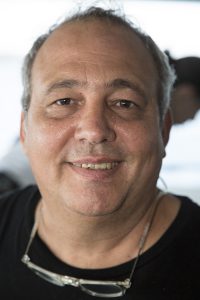
Carlos Manuel Alonso
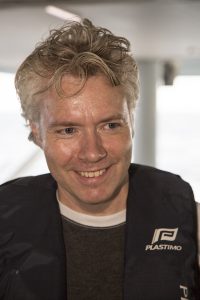
Hans Peter Arp
One of Race for Water’s chief goals is to advance scientific research by hosting international research teams. This year, the Race for Water Foundation has signed partnership agreements with the environmental organizations JPI Oceans and Plankton Planet. Launched in 2011, JPI Oceans is a strategic coordinating program on marine research, open to EU member states and EU associated countries. The program’s joint initiatives include the “Ecological Aspects of Microplastics” program, which serves as an umbrella for four projects, including EPHEMARE and Weather-MIC—that’s what the three Norwegians we picked up in Cuba are working on.
I’m an ambassador for Plankton Planet. Its goal is to study plankton biodiversity and health in every ocean on earth. It’s led by researchers from the CNRS—France’s National Center for Scientific Research—and includes a multitude of citizen investigators, recreational sailors who—like Race for Water—collect marine plankton out at sea. International oceanography experts then analyze those samples, and the data provide critical information on plankton biodiversity in the oceans, where it’s very difficult to gather good data. This study may help to get ahead of the threats to the marine lifecycle, and thus to humans as well.
60% of our oxygen comes from plankton
Cuban researcher Rosely Peraza Escarrá is an expert on plankton; she recently gave me some interesting details about these critical microorganisms. The term “plankton” includes any organism that drifts with the ocean currents—both phytoplankton and zooplankton. Plankton form the base of the food chain, and through photosynthesis, they produce approximately 60% of the oxygen that we breathe—nearly outpacing the earth’s forests. Plankton are at the forefront of environmental changes, and they react quickly to changes in the ocean environment caused by pollution and climate change. At the moment, a lack of data on biodiversity and the changes that plankton are undergoing are one of the biggest roadblocks to modeling the biosphere and predicting ecological change. Since the end of the 20th century, plankton populations have decreased dramatically. This is concerning, and may be caused by plastics pollution in the oceans, as well as by atmospheric pollution. That’s the driver behind the parallel studies—looking at both plastics pollution and plankton levels—being conducted on board Race for Water over the past three days.
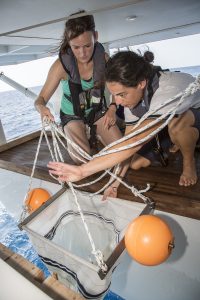
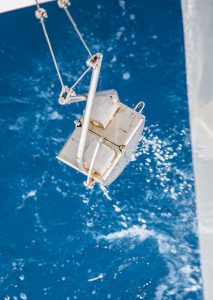
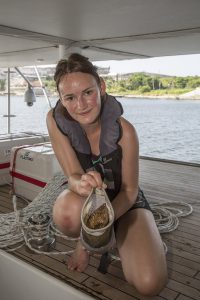
Operation Manta
Now, it’s all hands on deck. The international research team is already at work, under the direction of scientific team leaders Hans Peter Arp and Carlos Manuel Alonso. I’m not sure how they make sense of the jumble of test tubes and jars. Meanwhile, First Mate Annelore Le Duff and Engineer Martin Gavériaux are on the aft deck, unraveling a tangle of lines ahead of this morning’s launch of Operation Manta. A Manta net is like a big butterfly net that we drag behind the boat for 30-45 minutes at slow speeds. The difference is that we’re collecting ocean water samples, not butterflies. We take the first sample less than a mile after exiting the port, and the researchers are thrilled with the mud-like substance that we haul aboard. Dr. Hans Peter Arp tells me, “See all the tiny blue and white dots in the algae and organic matter? Those are microplastics. They’re taking over the oceans, and we’re studying their impact on marine animals.” Meanwhile, the Cuban team led by Carlos Manuel Alonso is collecting marine sediment using a sort of “stainless steel spider” that they lower to the ocean floor on a plumb line. Carlos explains that analyzing marine sediment is just as important as analyzing water, because—contrary to what was believed in the past—the sediment houses a great deal of micro-waste particles that are harmful to the environment.
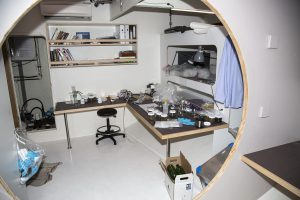
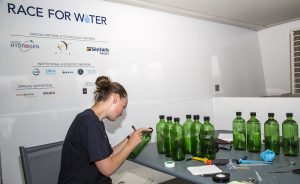
Over lunch, Carlos and Hans Peter gush about Race for Water’s on-board equipment and features, which make their work easier. The Foundation purchased the yacht (formerly the Planet Solar) in 2016, and completely renovated its interior for this mission’s purposes. The aft portion of the ship features a 40 m2 work area, including a winch and two direct-access water sampling points, and a self-contained dry lab with air conditioning, a fridge, freezer, water tank and an excellent work surface, plus a retractable staircase for divers, totaling over 100 m2 of flexible work space. In addition, Race for Water’s electric engines are quiet and produce zero emissions, so they don’t disturb marine animals. The yacht’s slow speed and stability make sampling easier.
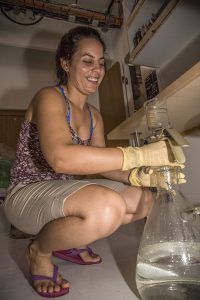
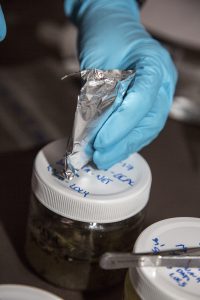
Which brings us to the second phase of the process: analyzing seawater samples, and—even more time-consuming—preparing those samples to be analyzed back on land. This task falls to researchers Arianna Garcia Chamero and Linn Merethe Brekke Olsen, who carefully transport the delicate glass bottles. As night gently falls over Cuba, Race for Water stealthily makes her way to her mooring at the end of a narrow dock lined with dilapidated buildings. One last ray of sunshine lights up Havana like a rainbow. Magic.
